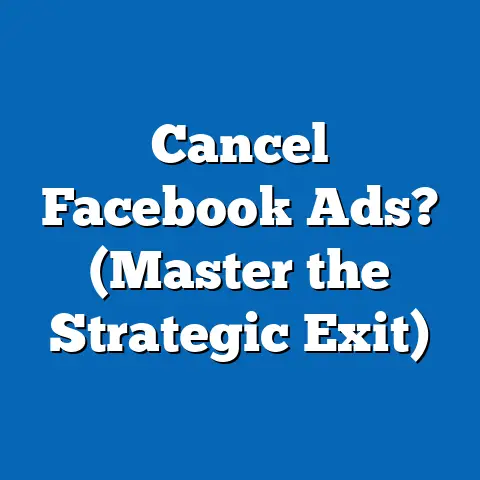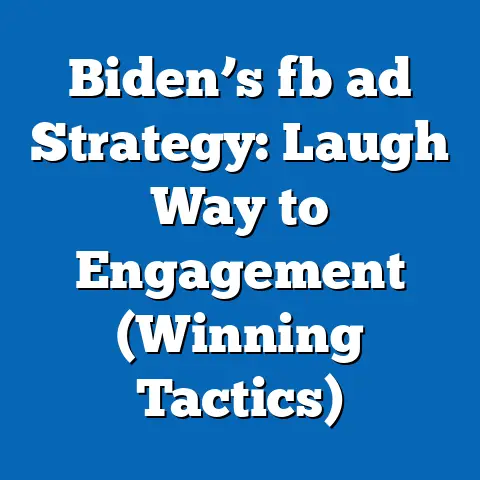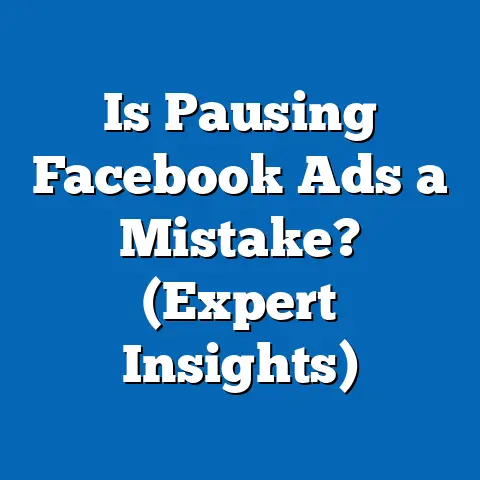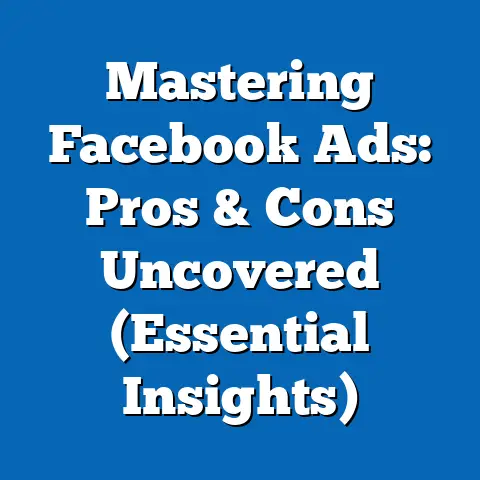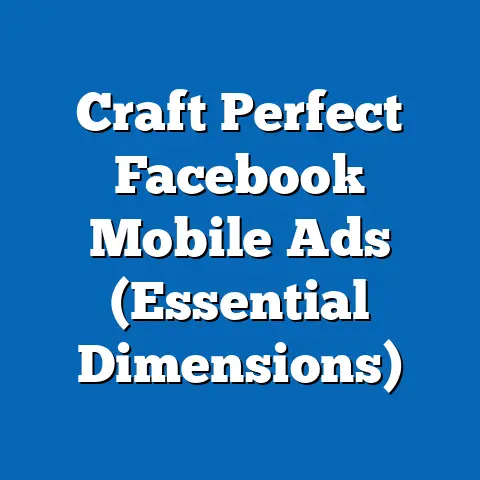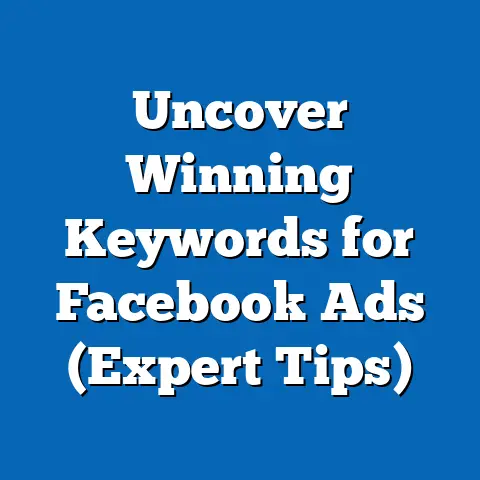Exclude Followers from Facebook Ads (Proven Strategies)
Facebook advertising. It’s a beast, isn’t it? I’ve spent years navigating its ever-changing landscape, and one thing I’ve learned is that conventional wisdom often falls short. One of the biggest myths I see circulating is that the key to Facebook ad success lies solely in targeting your existing followers. Sure, they already know and (hopefully) love your brand, but limiting your ad spend to just this group can be a massive missed opportunity.
Think about it: you’re preaching to the choir! You’re not expanding your reach, not introducing your brand to fresh faces, and potentially even annoying your loyal followers with constant ads. That’s where the power of strategic audience segmentation, and specifically, excluding your followers, comes into play. This isn’t about abandoning your existing audience; it’s about intelligently allocating your ad budget to maximize your return on investment (ROI), drive new customer acquisition, and ultimately, grow your business.
In this guide, I’m going to walk you through why and how to exclude your followers from specific Facebook ad campaigns. I’ll share my insights, back them up with data, and provide you with actionable strategies you can implement today to see real results. Let’s dive in and unlock the full potential of your Facebook advertising!
Understanding Audience Segmentation
Audience segmentation is the cornerstone of any successful marketing strategy, and Facebook advertising is no exception. In its simplest form, it’s about dividing your audience into distinct groups based on shared characteristics, behaviors, and interests. On Facebook, this could include everything from demographics (age, location, gender) to interests (hobbies, favorite brands) and behaviors (purchase history, website visits).
Why is this so crucial? Because one-size-fits-all messaging rarely resonates. I’ve seen countless campaigns fail because they treat everyone the same. Imagine trying to sell a high-end luxury watch to a college student or a budget-friendly car to a CEO. The messaging, the visuals, the entire approach needs to be tailored to the specific audience.
In the context of Facebook advertising, we can break down the audience into a few key segments:
- Followers: These are the people who already like your Facebook page. They’re familiar with your brand and have shown an interest in what you offer.
- Non-Followers: This is the vast pool of potential customers who haven’t yet connected with your brand on Facebook. They represent a significant opportunity for growth.
- Potential Customers: This is a subset of non-followers who are likely to be interested in your products or services based on their demographics, interests, and behaviors. This is where targeted advertising really shines.
The dynamics of customer behavior differ significantly between these groups. Your followers might be more receptive to certain types of content, like product updates or behind-the-scenes glimpses. Non-followers, on the other hand, need to be convinced that your brand is worth their attention.
Takeaway: Before launching any Facebook ad campaign, take the time to define your target audience and understand their unique needs and motivations. This will help you create more relevant and effective ads.
Why Exclude Followers?
Now, let’s get to the heart of the matter: why would you intentionally exclude your followers from your Facebook ads? It might seem counterintuitive, but there are several compelling reasons:
- Expanding Reach: Your followers already know about your brand. Excluding them from certain campaigns allows you to focus your budget on reaching new potential customers who might not otherwise discover you.
- Lowering Costs: In some cases, targeting a broader audience of non-followers can be more cost-effective than constantly bombarding your existing followers with ads. You might find that you can reach more people for the same budget.
- Avoiding Ad Fatigue: Even your most loyal followers can get tired of seeing the same ads over and over again. By excluding them from certain campaigns, you can prevent ad fatigue and maintain a positive brand image.
- Optimizing for Specific Goals: Different campaigns have different goals. For example, a product launch campaign might be best targeted at non-followers to generate initial buzz and awareness. A loyalty program campaign, on the other hand, might be better suited for your existing followers.
I’ve personally seen this strategy work wonders for product launches. Instead of focusing solely on followers who might already be aware of the upcoming product, excluding them allowed us to reach a much larger audience of potential customers. The result? A significant spike in initial sales and a broader customer base.
Real-World Example: A local bakery I worked with was launching a new line of vegan pastries. Instead of just targeting their existing followers (who were already familiar with their offerings), we excluded them from the initial awareness campaign and focused on reaching people interested in vegan food and desserts in their local area. This resulted in a huge influx of new customers and a successful product launch.
Of course, excluding followers doesn’t mean ignoring them altogether. You can re-engage them through other marketing channels, such as email marketing, organic social media posts, and loyalty programs. The key is to use paid ads strategically to reach new audiences and complement your other marketing efforts.
Takeaway: Excluding followers from specific Facebook ad campaigns can be a powerful strategy for expanding reach, lowering costs, avoiding ad fatigue, and optimizing for specific goals. Don’t be afraid to experiment and see what works best for your business.
Here are the proven strategies I use to exclude followers from Facebook ads, along with step-by-step instructions:1. Using Custom Audiences:
This is the most common and effective method for excluding your followers. Here’s how to do it:
- Go to Facebook Ads Manager: Navigate to the Audiences section in your Ads Manager.
- Create a Custom Audience: Click on “Create Audience” and select “Custom Audience.”
- Choose “Facebook Page”: Select “Facebook Page” as your source.
- Select Your Page: Choose the Facebook page you want to exclude followers from.
- Define Your Audience: Under “Events,” select “People who like or follow your Page.” This will create an audience of everyone who likes or follows your page.
- Name Your Audience: Give your audience a descriptive name, such as “Page Followers.”
- Save Your Audience: Click “Create Audience.”
Now you have a custom audience of your followers. To exclude them from your ad campaigns:
- Create or Edit Your Ad Set: Go to the ad set you want to modify or create a new one.
- Go to the Audience Section: Scroll down to the “Audience” section.
- Exclude Audience: Click on “Exclude” and search for the custom audience you just created (“Page Followers”). Select it.
That’s it! Your ad will now be shown to everyone except your followers.
2. Utilizing Audience Insights:
While not directly an exclusion strategy, Audience Insights helps you understand your existing audience and identify new potential customers. By analyzing the demographics, interests, and behaviors of your followers, you can create more targeted ads for non-followers.
- Access Audience Insights: Go to the Audience Insights tool in your Ads Manager.
- Select “People connected to your Page”: Choose this option to analyze your existing followers.
- Explore the Data: Review the demographics, interests, page likes, location, and activities of your followers.
- Identify New Interests: Look for interests and behaviors that are common among your followers but might not be immediately obvious.
- Create Targeted Ads: Use these insights to create ad sets that target non-followers who share these interests and behaviors.
3. Leveraging Lookalike Audiences:
Lookalike audiences are one of the most powerful tools in Facebook advertising. They allow you to find new people who are similar to your existing customers or followers.
- Create a Lookalike Audience: In the Audiences section of your Ads Manager, click on “Create Audience” and select “Lookalike Audience.”
- Choose Your Source: Select your “Page Followers” custom audience as the source.
- Select Your Location: Choose the countries you want to target.
- Choose Your Audience Size: Select the percentage of the population that you want to target. A smaller percentage (e.g., 1%) will result in a more targeted audience that is very similar to your source audience.
- Create Audience: Click “Create Audience.”
Facebook will now create a lookalike audience of people who are similar to your followers but are not already connected to your page. You can then target this audience with your ads.
4. Setting Up Ad Campaigns:
Here’s a step-by-step guide on how to set up ad campaigns that incorporate these exclusion strategies:
- Create a New Campaign: In your Ads Manager, click on “Create” to start a new campaign.
- Choose Your Objective: Select the objective that aligns with your campaign goals (e.g., awareness, traffic, conversions).
- Set Your Budget and Schedule: Define your daily or lifetime budget and choose the duration of your campaign.
- Create Your Ad Set: This is where you’ll define your target audience.
- Define Your Target Audience:
- Location: Select the geographic locations you want to target.
- Age and Gender: Define the age range and gender of your target audience.
- Detailed Targeting: Use detailed targeting to reach people based on their interests, behaviors, and demographics.
- Exclude Audience: This is where you’ll exclude your “Page Followers” custom audience.
- Lookalike Audience: Consider including a lookalike audience based on your followers.
- Choose Your Ad Placement: Select where you want your ads to be shown (e.g., Facebook feed, Instagram feed, Audience Network).
- Create Your Ad: Design your ad with compelling visuals and persuasive copy.
- Track Your Results: Monitor your ad performance closely and make adjustments as needed.
- Location: Select the geographic locations you want to target.
- Age and Gender: Define the age range and gender of your target audience.
- Detailed Targeting: Use detailed targeting to reach people based on their interests, behaviors, and demographics.
- Exclude Audience: This is where you’ll exclude your “Page Followers” custom audience.
- Lookalike Audience: Consider including a lookalike audience based on your followers.
Personal Story: I once worked with an e-commerce brand that was struggling to acquire new customers. They were spending a significant portion of their ad budget on targeting their existing followers, but their sales weren’t increasing. We implemented a strategy of excluding their followers from their acquisition campaigns and focusing on reaching lookalike audiences. Within a few weeks, they saw a significant increase in new customer acquisition and a substantial improvement in their ROI.
Takeaway: By using custom audiences, audience insights, and lookalike audiences, you can effectively exclude your followers from specific Facebook ad campaigns and reach new potential customers.
Measuring Success
Excluding followers is just one piece of the puzzle. To truly optimize your Facebook advertising, you need to track your results and measure your success. Here are the key metrics and KPIs you should focus on:
- Reach: This is the number of unique people who saw your ad. By excluding followers, you should see an increase in your reach, as you’re now reaching a wider audience.
- Impressions: This is the number of times your ad was shown. A higher number of impressions indicates that your ad is being seen more frequently.
- Click-Through Rate (CTR): This is the percentage of people who saw your ad and clicked on it. A higher CTR indicates that your ad is resonating with your target audience.
- Conversion Rate: This is the percentage of people who clicked on your ad and completed a desired action, such as making a purchase or filling out a form. A higher conversion rate indicates that your ad is effectively driving results.
- Cost Per Acquisition (CPA): This is the cost of acquiring a new customer through your ad campaign. A lower CPA indicates that your campaign is more cost-effective.
- Return on Ad Spend (ROAS): This is the revenue generated for every dollar spent on advertising. A higher ROAS indicates that your campaign is generating a good return on investment.
Facebook provides a wealth of data and analytics that you can use to track your ad performance. You can access this data in your Ads Manager and create custom reports to track the metrics that are most important to you.
A/B Testing:
A/B testing is an essential part of optimizing your Facebook advertising. It involves creating two versions of your ad (A and B) and testing them against each other to see which performs better. You can A/B test different aspects of your ad, such as the headline, the image, the targeting, and the placement.
Example: You could create two versions of your ad, one that targets non-followers and one that targets your existing followers. By comparing the performance of these two ads, you can see which audience is more responsive and adjust your strategy accordingly.
Key Metrics to Track:
- Cost per click (CPC): How much are you paying for each click?
- Relevance score: Facebook’s assessment of how well your ad resonates with the target audience.
- Landing page views: Are people who click actually making it to your landing page?
Takeaway: Track your results, measure your success, and use A/B testing to continuously optimize your Facebook advertising campaigns. Data-driven decision-making is the key to maximizing your ROI.
Conclusion
Strategic audience segmentation, including the exclusion of followers from certain campaigns, is a game-changer in Facebook advertising. It’s about shifting your perspective from simply reaching those who already know you to actively seeking out new potential customers.
By implementing the proven strategies I’ve outlined in this guide, you can:
- Expand your reach and introduce your brand to a wider audience.
- Lower your costs and make your ad budget go further.
- Avoid ad fatigue and maintain a positive brand image.
- Optimize your campaigns for specific goals and drive real results.
I urge you to evaluate your current Facebook advertising strategies and consider implementing follower exclusion tactics. Don’t be afraid to experiment, track your results, and adjust your approach as needed. With the right strategy and a data-driven mindset, you can unlock the full potential of Facebook advertising and achieve your business goals.
Now, go forth and conquer the Facebook advertising landscape! Start by creating that custom audience of your followers and excluding them from your next awareness campaign. I’m confident you’ll see a positive impact on your reach and overall ad performance. Let me know how it goes!

